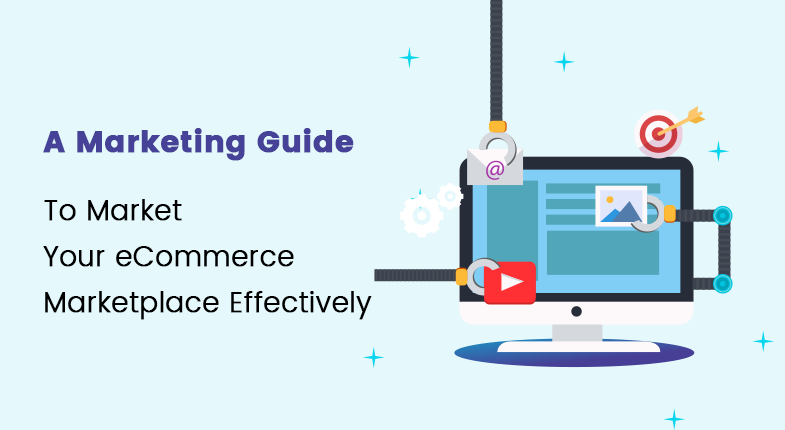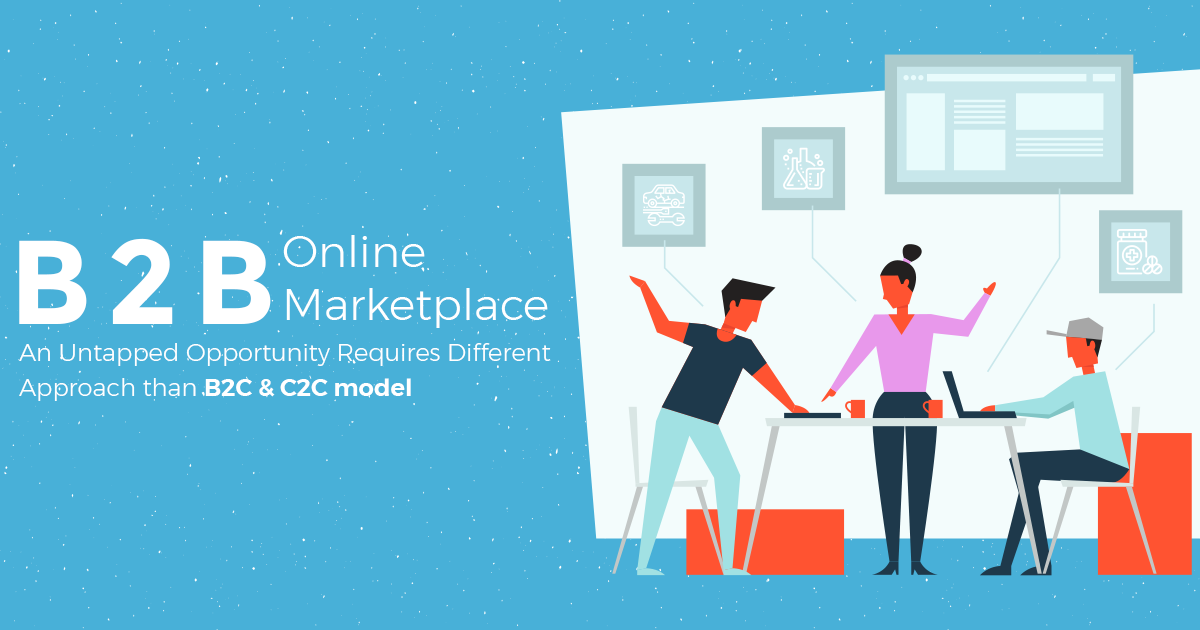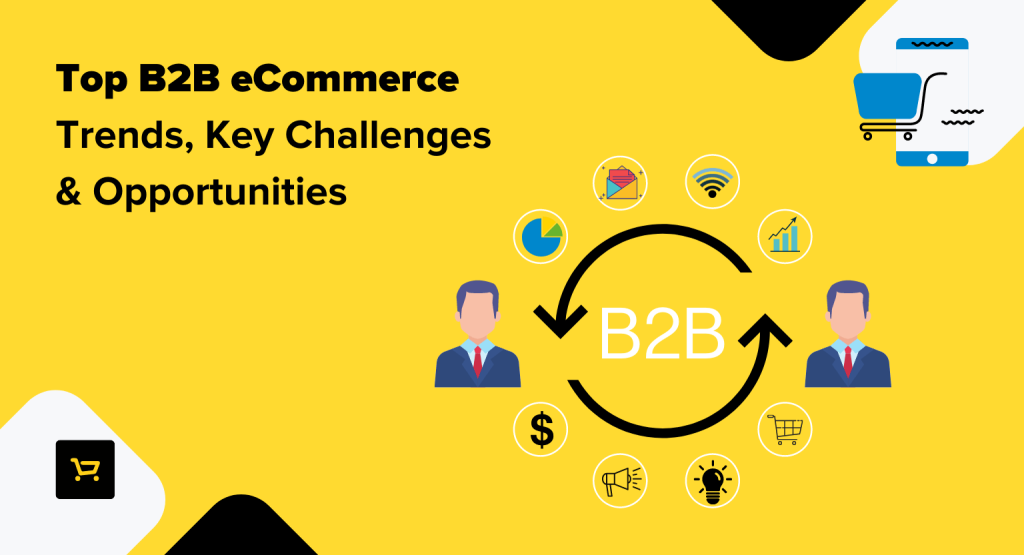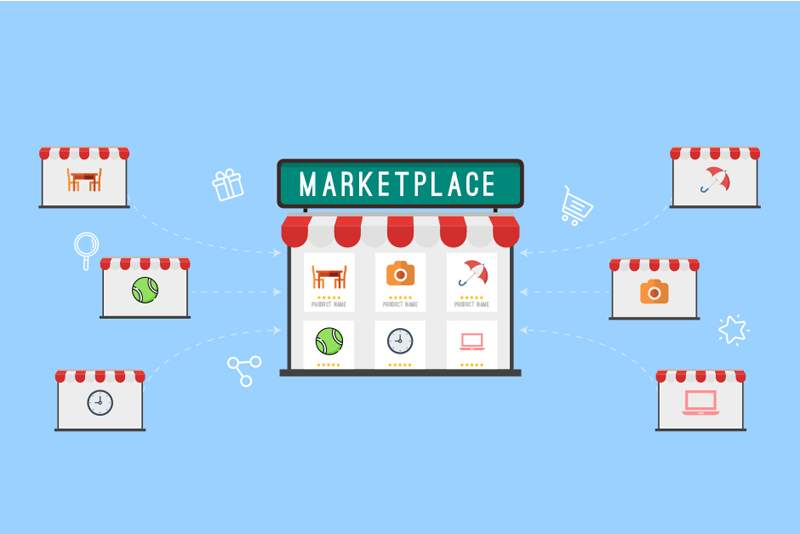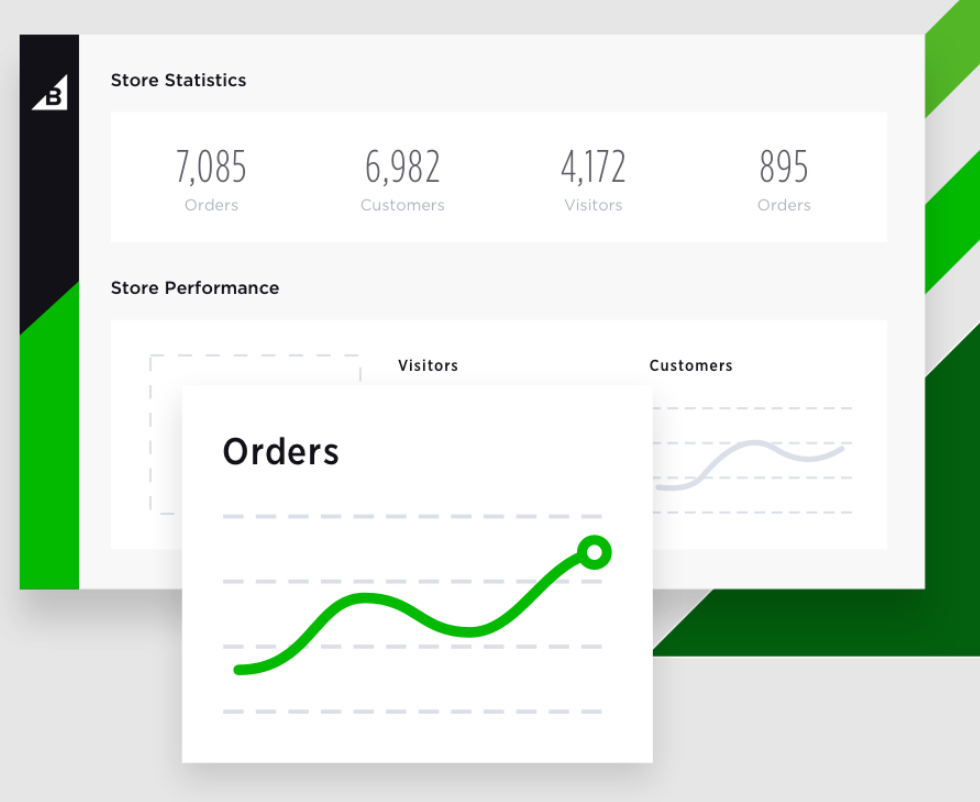Amazon, Airbnb, and Uber are the three most famous examples of how technology has disrupted entire industries and for a good reason. They have created a new kind of marketplace in eCommerce, from supply to generating demand.
Today, we may take their success for granted. However, the road to success wasn’t easy for them. Imagine convincing consumers to stay or ride with strangers through a mobile app or to shop anything, from staple goods to niche electronic products, from just one website.
Sounds challenging indeed!
There are many types of businesses, but eCommerce marketplaces are the hardest to get off the ground. That’s because one has to acquire two types of users simultaneously – buyers and sellers. And it’s crucial for both parties to scale together for a marketplace to thrive.
As the title suggests, “A Marketing Guide to Market Your eCommerce Marketplace Effectively” specifically talks about the best marketing practices that can be applied by struggling business owners and marketers to boost promotions of their marketplace, and in turn generate more revenue.
If you are also currently in a tight spot, you might find the giveaways in the guide handy.
Have a look:
Eight promotional strategies to take advantage of
1) Create a content plan
In 2018, only 39% of content marketers documented their content marketing strategies. That number, however, jumped to 65% among top performing organizations. [CMI and MarketingProfs]

Make a list of all the platforms you plan on using to reach your potential customers. That could include blog posts, podcasts/webinars or newsletters. Keep in mind the current trends and upcoming events in a year while creating a strategy for your eCommerce marketplace.
You could set targets for each week, month and year and evaluate how the content creation and syndication process is progressing periodically.
With HubSpot and CoSchedule, you can create custom views of your marketing calendar that are interactive and can update in real-time.
Remember: content is of the essence in this age and time. So whatever marketing initiatives you plan must start with content.
2) Strengthen your SEO
72% of online marketers describe content creation as their most effective SEO tactic. [HubSpot]

Start with the basics. Optimize product listing titles and descriptions on your website with SEO keywords to increase traffic. Incorporate frequently-searched terms and phrases into the web content for better search rankings.
Tools like Ahrefs and Google Keyword Planner can be used for identifying relevant SEO keywords for your eCommerce marketplace.
Once the web content has been optimized, measure the effectiveness of your SEO strategy with Google Analytics from time-to-time, and check which keywords are the organic reason behind increased traffic and higher sales.

(Image Source – https://cdn-images-1.medium.com/max/2000/1*pVhLMfxXmHTtHPCh1_ac_Q.png)
3) Use social media organically

Source: Pew Research Center
Create a social media calendar to post regularly at times your customers are most active on. You don’t need to spread yourself thin and use all the platforms. Instead, focus only on those social networking channels that your customers use. Keep a mix of posts including industry-related trends, product offers, customer testimonials, and company news to enable a consistent social presence.
Buffer and AgoraPulse are user-friendly tools that not only automate posts but also offer a detailed analytics report for tracking the posts’ performance from one central location.
4) Run paid ads on social media
Once the organic social presence of your eCommerce marketplace has become stable, start executing paid campaigns on select social media sites. According to us, these are the most popular platforms that serve ads:
a. Facebook
93% of marketers use Facebook to run social ads on a regular basis. [Social Media Examiner]
Although Facebook’s popularity has taken a dip in recent times, it still has a unique advantage over others when it comes to advertising. You can target your ads on Facebook by age, gender, and interest – which makes it easier for advertisers to narrow down their audience for better results.

(Image Source – https://www.referralcandy.com/wp-content/uploads/2016/12/facebook-dynamic-product-ads.jpg)
Small to midsize businesses opt to run marketplace ads on Facebook as they have better click-through rates and lower cost-per-action numbers.
b. Twitter
72% of the users who follow brands on Twitter are likely to purchase items or services from them. [Simply Measured]
Similar to Facebook advertising, you can target prospective customers by gender, interest, and geography on Twitter. However, the channel has a unique cost-per-action model.
You pay only when a user follows your Promoted Account or when they favorite, retweet, reply or click on a link in your Promoted Tweet. You can decide the metric you want to measure – depending upon what you’d like to achieve from the paid campaign.
Twitter marketing might be worth a try if you are looking to spread awareness about a new service or the latest company development.
c. Instagram
Instagram stories are posted by 200+ million people on a monthly basis, making them an excellent way to reach your target audience. [Statista]
Ads on Instagram are on the rise, and you’ll find businesses, especially from eCommerce, promoting their products and services on it. From running a contest to a sponsored post – Instagram is a great way to boost brand visibility and to ensure higher sales.
Moreover, you can start with a low budget, in the beginning, to test the waters on the channel, and then gradually increase the amount.
Alternatively, you can add products to your Instagram posts and stories and include a direct link for customers to purchase from the app itself.

(Image Source – https://blog.adstage.io/2017/11/07/instagram-ad-cost-report)
Planoly, a visual planner for Instagram and Iconosquare, an analytics and management platform, can help in creating a niche strategy for your eCommerce marketplace’s Instagram.
5) Utilize PPC advertising
PPC stands for pay-per-click which means businesses pay for every click that their ad receives.
The reason PPC advertising is useful is that it enables you to measure whether or not your campaigns are cost-effective by comparing the amount of traffic and sales generated by an ad with the ad costs.
Google Adwords is the most popular PPC feature that works on the auction process. Create a set of adverts before identifying a keyword, related to your eCommerce marketplace, on which you want to bid.

(Image Source – https://searchenginewatch.com/wp-content/uploads/sites/25/2018/06/the-new-adwords-dashboard.jpg)
The ads are then chosen on bid amounts and the ad’s quality score and subsequently displayed to the target customers on their Google feed and relevant publications. PPC ads have to be improved on an on-going basis to ensure the click money is being spent wisely.
6) Leverage your email marketing
Email ranks third amongst the most influential sources of information. [WordStream] 77% of consumers would rather receive promotional content via email than through SMS or social media. [Exact Target]
Since consumers are interested to know how a product or service can benefit them, they are more likely to engage with offers or discounts that serve their needs. And what better than emails for that?
Contrary to popular belief, emails are still considered the most effective eCommerce marketing strategy for influencing consumers and convincing them to buy more.

(Image Source – Google.com)
Set an email marketing plan for every month and make sure you share a mix of content with your subscribers. That could include FAQs, service additions, product discounts, any press release or media coverage of your marketplace, and more.
A Guide to Marketing your eCommerce Marketplace Effectively
AWeber, MailChimp, ConstantContact, GetResponse, and CampaignMonitor are some of the popularly used email software in the market.
7) Collect consumer-generated content
User-generated content is great because it’s organic and honest, and it inspires customers to get involved with your business without any money or time investment from your end. It also ensures a whopping 73% higher click-through rate.
Doritos, for instance, holds a Super Bowl commercial submission contest on an annual basis which means they don’t have to pay the production crew a single penny to design a video. Moreover, the engagement levels of the Doritos fans are at an all-time high around this time, and the brand gets a commercial to air without having to break the bank!

(Image Source – http://videocontestnews.com/2010/01/05/doritos-2010-crash-the-superbowl-finalists/)
User-generated content could be in the form of reviews and ratings. You can choose to do a blog series or an Instagram story – depending upon the nature of your eCommerce marketplace – to highlight a positive review of your product or service.
8) Vendor engagement is key
Absolutely! Without vendors, your eCommerce marketplace cannot function. To enable a smooth working relationship with your vendors, make sure you onboard and train them properly on your operational processes.
At eCommerce marketplaces, vendors are rated by buyers on various parameters like on-time shipment dispatch, unresolved cases, transaction defects and more. Notify them of the poor ratings so that they are well aware of how they are performing on your site, and make necessary amends soon.
Always include the vendors in your marketing when finalizing Black Friday discounts, New Year offers or End of Season deals. They will feel appreciated and heard.
Lastly, vendors could be left unsatisfied with product returns, overdue payments, product returns or unresolved disputes. That’s why it’s best for you to keep asking for feedback continuously.
The key is always to keep them in the loop!
Five sales generation tactics to apply
1) Re-market or remind customers via push
Consumers of today are spoilt for choice and prefer to hop from one online store to another. Therefore, it isn’t surprising to search for a hack that can help you re-engage with your prospective customers.
One way to pique their interest is by sending a push notification (mobile or web) on the product they were browsing through when they were previously on the website.
If they have abandoned their shopping cart and bounced off the website (which is a high possibility), you can send them a push notification to remind them to complete the purchase.

(Image Source – http://puch%20notification/)
To make things interesting, you can even offer them a small discount or an upsell package deal to come back to the website and complete the purchase.
2) Upsell and cross-sell
When the seller encourages consumers to spend more than they had initially planned to, that type of sale is called an “upsell.” It also goes by different terms like “add-on sales” and “bundle sales.”
As of today, 81% of consumers do some sort of online research before a potential purchase. This means they want to assure themselves that when they make a purchase, they get maximum value out of their decision.
To begin with, make a list of all products your marketplace is selling and divide them into two categories – regular ones and expensive ones. Tie the more expensive product with a regular one. 4% of your customers will buy the more expensive product only because it has been positioned that way.
Similarly, cross-sell is a strategy to sell related products with something a consumer is already buying. Cross-sell products should be at least 60% cheaper than the product added to the cart. If you give your customers a complete package – for instance, a camera and batteries at a lower price – they will not think twice before buying both.
3) Make product recommendations
Product recommendations increase revenue by up to 300%, conversion rate by 150% and average order value by 50%. Forrester and Gartner
If you look up “product recommendations” on the internet, there’s one line that will pop up on your feed many times: “70% of Amazon’s homepage is dedicated to product recommendations.”
It is true. The eCommerce marketplace has pioneered the concept of recommending products to its website visitors.
If you are a first-time visitor on Amazon, you will find general recommendations such as “What Other Customers Are Looking At Right Now” or any “Best Seller.”

(Image Source – https://beeketing.com/blog/how-product-recommendation-helps-e-commerce-sites-increase-conversion-rates/)
If you revisit it, you will find personalized recommendations on the homepage that are based on your previous visits’ browsing history.
No wonder Amazon has tapped the potential of product recommendations and so should your eCommerce marketplace.
4) Build a brand community with loyalty programs
It’s a given that discounts and freebies are helpful in not only converting a customer but also nudging him or her to keep coming back for more. However, if you want your eCommerce marketplace to be profitable consistently, then it needs to build a community.
And one way to do so is via loyalty programs.
Take Amazon Prime for example. Those memberships are over 100 million in the US alone, with the eCommerce giant aggressively branching out to other countries like Mexico, China, and Canada.
Amazon Prime means multiple things: faster shipping of products bought on Amazon, access on-demand video and special product discounts. With a membership cost of $119 per year, having Prime is worth it for frequent Amazon users.
You could also start a loyalty program for your eCommerce marketplace. Through the loyalty program, your customers may be given:
- Rewards
- Free merchandise
- Discounts and rebates
- Coupons
- Access to unreleased products
Remember: It costs 5X less to retain customers than to acquire new ones and loyal customers spend up to 67% more than new customers. Therefore, work on creating lifetime customers for your eCommerce marketplace.
5) Increase checkout conversion with A/B testing
When the customers move to the check-out page, they have already conveyed that they are ready to purchase from you and no longer use the cost of the product or service as a parameter to complete the transaction.
However, many businesses lose customers due to a poor checkout experience. The reasons for the same could be many:
- Long contact forms
- Less number of payment options
- Tedious “reset password” process
- Hidden shipping costs
- Unattractive CTAs
Check out SimCity’s checkout page variations. The “Variation” page performed better by 43%.
To ensure that it doesn’t happen to your eCommerce marketplace, make multiple checkout pages to see which one customers respond to best.
Take away
There’s no secret recipe for overnight success. You need to market your business consistently and be open to making improvements along the way.
Remember:
- Always plan your marketing activities. CoSchedule and Smart Insights offer free templates for content, social media, and email marketing.
- Keep aside a set budget to run paid social ads. How you distribute that money across different networking channels depends on the real-time ad performance.
- Study analytics frequently to identify which blog post, social media ad, email or web page is performing well and what’s not. Make amends accordingly.
Questions? Speak to us!
Your eCommerce marketplace deserves all the success in the world, and it is imperative to address any queries regarding the eCommerce Software Solution you may have. The good news is we are a team of eCommerce experts always at your service. Contact us anyhow you like, and we’ll help you at the earliest.
